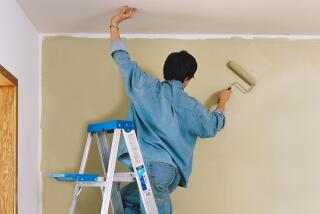Year in the Life of Efficient House Includes a Chore for All Seasons
Now is a good time to begin a monthly maintenance regime, according to Linda Blair, an interior decorator in Scarsdale, N.Y., and former president of the New York area chapter of the American Society of Interior Designers.
“I don’t want to be Heloise,” she says, “but maintenance has to be part of interior decorating, because no home furnishings are impervious.”
Start, she says, by taking a walking tour through the house, “looking for chipped paint, furniture nicks, spots and worn areas in carpet and upholstery, broken tiles and yellowing wallpaper. And make a list of remodeling, renovation, repair and replacement projects that you might like to tackle.”
In her book “Design Sense” (John Wiley & Sons, $29.95), Blair devotes a long chapter to home maintenance and the small chores that help a room keep its sparkle long after the decorator leaves.
Twice a year, for example, flip sofa and chair cushions so they can wear evenly and slightly shift the occasional tables on the rug so the legs don’t make permanent dents in the pile. Both chores are quick and easy and should lead to a longer life for the furnishings.
Blair divides household maintenance tasks into three categories: organizing, cleaning and refurbishing--in the belief that a well-organized home is easier to clean and refurbish.
For someone just starting regular maintenance, now is ideal for organizing. Start by gathering household insurance policies, instruction booklets for appliances and names of plumbers, electricians and other service people and put them into a file labeled “household.”
Late winter also is a good time to acquaint yourself with the nuts and bolts of the house, identifying essentials such as water and gas shut-off valves, labeling the fuse box or circuit breakers, and learning how the fireplace works.
Have duplicate keys made for household locks, and inventory tools to be sure that the basics such as scissors and screwdrivers and emergency items such as batteries, flashlights, candles and extension cords are on hand and in working order.
Spring cleaning has been a ritual in many cultures through many eras. There’s a sense of renewal in taking down the curtains, washing windows and clearing rooms of winter’s stale air.
A change in weather with the approach of spring is a natural time to focus on cleaning. Include dusting the baseboards, moldings and cabinet tops and wiping down cabinets and mirrors.
Spring, with longer days and brighter sunlight, also is a time when threadbare spots and stains on rugs and furniture are most evident.
“I don’t want to give the impression that it’s bad to have faded pieces,” Blair says. “I love old pieces of furniture--chipped painted pieces and aged chenille and velvet fabrics.”
But not everything shabby is chic, she says.
With spring chores finished, spend the summer outdoors. Come fall, resume indoor tasks. Among them: Removing and dusting books on the shelves, checking out the weather stripping and making sure the fireplace is in working order. It’s also a good time to take apart shower heads and kitchen faucets and clean them of sediment and mineral deposits.
While many chores can be handled by family members, calling the professionals can save time and often bring superior results. A professional cleaning of rugs and upholstery every few years should make them last longer. And unless you’re really handy, all but the most minor electrical and plumbing work is best left to licensed professionals.
“The first year, before the tradition becomes routine, will be the hardest,” Blair says.
But once the schedule is in place--and you stick to it--you should have more free time next December. And while virtue is supposed to be its own reward, you may find entertaining more enjoyable.
“If you do not need to undertake a major cleanup before guests arrive,” Blair says, “you’ll find yourself issuing invitations more frequently.”


